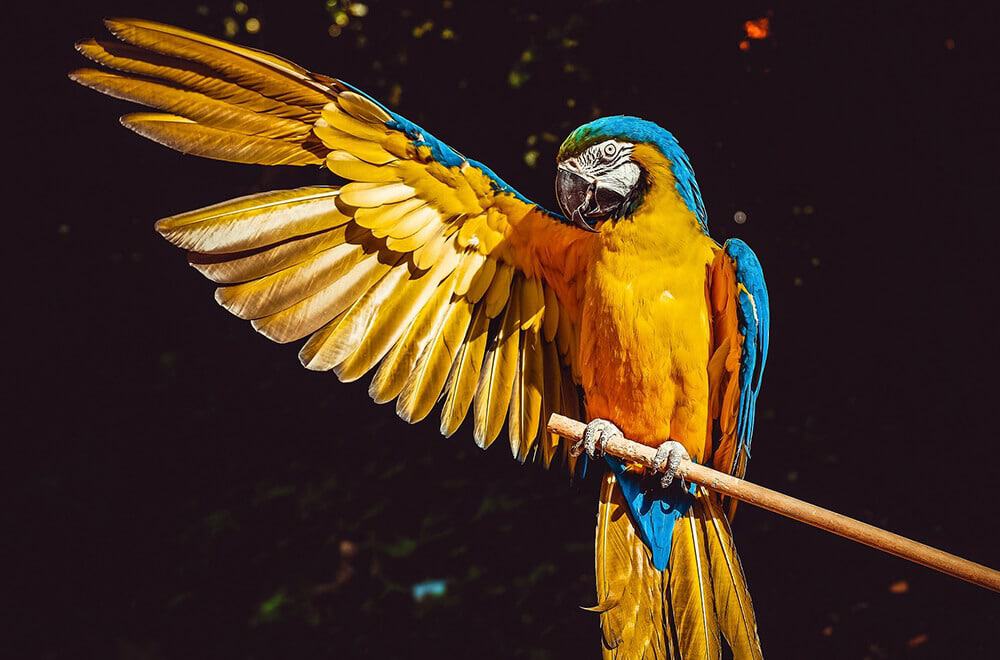Macaws have long tails to help them balance and maneuver through the forest canopy. Macaws navigate through their environment by clinging to branches with their beaks and claws, and their long tails serve as a counterweight, allowing them to make tight turns and sudden movements while flying.
Macaws are known for their vibrant plumage and ability to mimic human speech. They are also known for their unique long tails, which can make up more than half of their overall length.
These magnificent birds are native to the rainforests of Central and south America, where they live in flocks and feed on fruits, nuts, and seeds.
In this article, we’ll explore why macaws have long tails in greater detail and examine how these tails help macaws survive in their native habitat. So, let’s dive in and explore the fascinating world of macaws!

Credit: www.dreamstime.com
The Function Of Long Tails
Macaws are incredibly majestic birds with vibrant colors, which are hard to miss. However, their long tails play a significant role in their lives. The primary purpose of a macaw’s long tail is to help them balance during flight. These tails serve as a rudder and allow macaws to control their mid-flight trajectory, so they can fly with ease.
Also, long tails help macaws avoid obstacles while flying in dense forests. With their tails, macaws can quickly shift their direction while avoiding obstacles. Macaws’ long tails are more than just a beautiful feature; they help these magnificent birds easily navigate the sky.
Sexual Selection
Macaws are known for their spectacular, long tails resulting from sexual selection. Sexual selection occurs when certain physical features become desirable in potential mates. Evolutionarily, macaws with longer tails have been selected as mates because they are seen as stronger and better equipped to survive.
As a result, the genes for longer tails are passed down through generations. Today, macaw owners continue to choose birds with longer tails as pets, perpetuating this desirable trait. So if you’re wondering why macaws have such long tails, the answer lies in the mating preferences of these beautiful birds.
Macaw facts 🦜 group of New World parrots that are long-tailed and often colorful
Improving Flight Efficiency
A macaw’s long tail feathers work in tandem with its wings during flight, increasing efficiency. The bird can control its direction and speed in the air by changing the position of its tail feathers. These feathers act like a rudder on a boat, helping to steer the macaw.
Additionally, the length and weight of a macaw’s tail feathers help to balance the bird during flight. Without this balancing mechanism, the macaw would have to expend more energy to maintain its position in the air. Macaws’ long tails are an essential adaptation that allows them to fly efficiently.
Environmental Factors
Macaws are evolutionary marvels since they’ve intelligently adapted to their distinct environment. These birds are renowned for their long tails, which are an essential tool for their survival. The environment and ecosystems in which these birds reside have strongly influenced the development of their prodigious tails.
The tropical Amazon rainforest, where most macaws are found, is also abundant in trees of different sizes and thicknesses. The trees provide macaws with suitable habitats and plenty of food. The macaws use their long tails as a support system, which allows them to climb and perch effortlessly.
Furthermore, the long tails provide agility in the air, which is necessary for escaping predators. Different species of macaws that reside in distinct environments have adapted their tails differently. For example, the blue-and-gold macaw, which inhabits the savannahs and lightly wooded regions, has a shorter tail than the hyacinth macaw, which lives in dense rainforests.
Conclusion
The long tail of the macaw serves multiple purposes, acting as a balance beam, a communication tool, and a self-defense weapon. While there is no single answer to why macaws have long tails, it is clear that their tail feathers play a crucial role in their survival.
From navigating the dense forest to attracting a mate to escaping predators, macaws have evolved to utilize their long tails to their advantage. As human activity increasingly encroaches on their habitats, it’s more important than ever to appreciate and understand these fascinating creatures and the unique adaptations that have allowed them to thrive in the wild.
By protecting their habitat and promoting conservation efforts, we can help ensure that macaws continue to grace our skies with their vibrant colors and long, graceful tails for generations to come.




